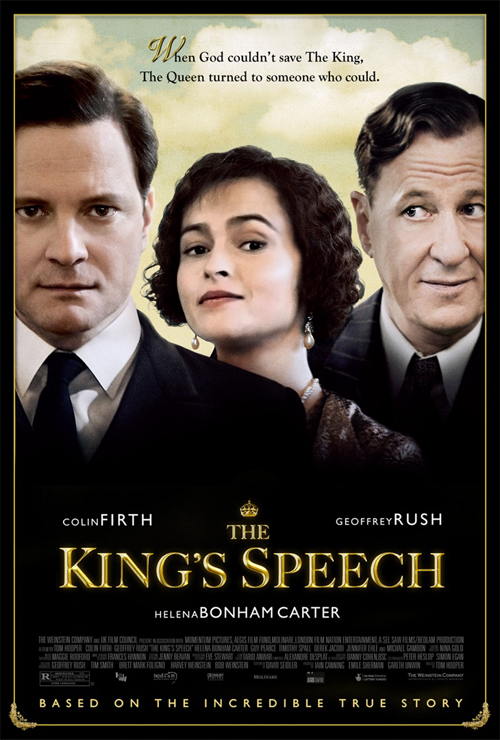The King’s Speech (Tom Hooper, 2010): UK/Australia
Reviewed by Tyler Gilbert. Viewed at Grauman’s Chinese Theatre, AFI Film Festival, Hollywood.

The King’s Speech was eagerly anticipated on the night of November 5. With an all-star cast (Colin Firth, Geoffrey Rush, Helena Bonham Carter, Timothy Spall, and Michael Gambon to name a few) the film brought over a thousand moviegoers into the Chinese Theatre to witness the difficulties faced by who Colin Firth says is a “remembered and loved” king: King Henry VI. The script, originally adapted for the stage, was picked up by director Tom Hooper and transformed into a film that has now garnered four awards with eight others still pending. The plot details the hurdles King Henry VI (Colin Firth) faced while on the throne in the 1920s and ‘30s owing to his severe stammer. Having failed numerous public addresses, the king’s wife, Queen Elizabeth (Helena Bonham Carter) locates Australian speech therapist Lionel Logue (Geoffrey Rush) in the classifieds. Very different from the other therapists in London, Logue puts the king through a challenging and humiliating process, pushing him outside his comfort zone so often that the two form an unlikely friendship, which the king struggles to embrace, being a member of the royal family. Logue explains to the king that a stammer is not a biological problem; anyone with a stammer can speak clearly when they’re not conscious of themselves. As absurd as the king finds this, he continuously returns to Logue for further training, and his triumphs due to Logue’s assistance give him the courage to remain a strong, confident king.
Colin Firth’s acting combined with close, restricting cinematography when the king speaks, give a completely realistic impression of the king’s struggles throughout the film. It often takes great patience on the audience’s behalf to make it through Firth’s lines and to understand what he is trying to say. Perhaps one of the most spectacular things about the film is that never once was the reality of the king’s impediment cut short; it continually felt like a overwhelming burden, both for the king and for the audience. So propelled by his battle with himself, the audience is just as driven to help the king overcome this hurdle as Queen Elizabeth and their nation is. Interestingly, while the film portrays the stammer as a negative aspect of the king, and while his scenes of failure are uncomfortable and distressing, it shines a positive light on the problem, recognizing how humiliating it can be for people with stammers, but never blatantly ridiculing it. This allows those who share the king’s speech impediment to try and overcome it with him. His triumphs under Logue’s tutelage are inspirational even for those who do not have a stammer, but who have difficulties addressing a large crowd—an issue that has always been prevalent.
The King’s Speech addresses these issues and can be seen as a source of great encouragement. Because it shows how one very significant member of history has gone through the humiliation and torment of having a stammer, it motivates those, like the writer of the script David Seidler, to believe in themselves. Furthermore, it also inspires those who battle with other social problems to conquer them, whatever the problem may be. The film speaks quite clearly that any difficulties are vanquishable as long as one has the strong desire to do so. The King’s Speech is a winner, and its message can make winners. Anyone looking for inspiration would do well to see this film.
About this entry
You’re currently reading “The King’s Speech (Tom Hooper, 2010): UK/Australia,” an entry on Student Film Reviews
- Published:
- 11.14.10 / 8pm
- Category:
- AFI Filmfest 2010, Films
2 Comments
Jump to comment form | comments rss [?] | trackback uri [?]